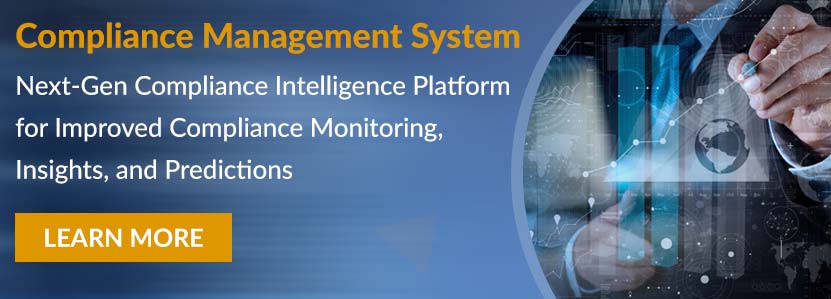Home/ Blog / Four Simple Steps to Boost Compliance Management
A recent survey by ACAMS (Association of Certified Anti-Money Laundering Specialists) revealed how businesses, mostly financial institutions (71% of the respondents belonged to BFSI), are managing compliance and the challenges they face. More than 63% of respondents were concerned about delays in compliance issues occurring and being reported. The importance of AI (Artificial Intelligence) technology is widely respected across the industry as well with 92% saying AI can help curtail financial crimes. The survey results reinforce the argument that businesses need a better and more efficient method of managing compliance levels.

Compliance management is necessary to guarantee that firms effectively manage risks. However, many businesses are dissatisfied with the outcomes. No matter how many resources they devote to compliance management, the results appear to remain consistent. That is because compliance management is not a process that can be improved simply by expanding the staff who work on it — there are diminishing returns on compliance personnel increases. If firms want to make a difference, they must examine and enhance their overall compliance management system.
Increase Compliance Visibility
We can only manage what we can control, and we can only control what we are aware of. What’s striking is that the majority of compliance managers are forced to maintain compliance standards in the absence of any holistic perspective of the firm. They have little visibility into how compliance is enforced across the organization but are held accountable if something goes wrong.
While it is the compliance manager’s or officer’s responsibility to assure compliance, if we genuinely want them to do their duties properly, we must provide them with considerable visibility over organization-wide compliance. This is a significant issue with the way many businesses approach compliance. Non-compliance must be manually identified and conveyed to the manager; otherwise, the manager will be unaware of the problem.
Unify Compliance Repositories
The next step is to establish a common repository for information about compliance management. This is another significant issue that firms face – compliance information is dispersed throughout the corporation. Duplicates of the same file exist on various machines. Multiple versions of the same document are scattered throughout people’s email inboxes—server-side files and forms. There is no centralized repository for compliance and information data.
Organizing and storing all of this information in a single spot gives various advantages. It facilitates collaboration. It enables management to more easily monitor the many compliance efforts currently underway. It enables users to quickly locate and verify any information or reference contained in another document.
The importance of AI (Artificial Intelligence) technology is widely respected across the industry as well with 92% saying AI can help curtail financial crimes. Share on XAutomate the Routine Compliance Management Tasks
Compliance officers and managers devote a large proportion of their work hours to mundane tasks. The compliance officer/manager possesses specialized knowledge and is thus an expensive hire. To require them to spend so much time on tasks that can be automated is wasteful. Modern compliance management solutions automate duties ranging from simple task scheduling to complicated tasks like as compliance monitoring.
At this point, we may reasonably anticipate that automation will eventually perform most routine data gathering responsibilities. Numerous technologies are already available that automate significant portions of compliance management. It is likely that it will take only a few more years for us to develop the technologies necessary for complete compliance automation.
Establish a Compliance Culture
The final and most critical step firms may take to improve compliance management is to cultivate a compliance culture. Certain businesses operate as if they were ‘born compliant,’ while others fight to maintain compliance to the best of their abilities. With some training, monitoring, and process reengineering, we can foster a culture in which compliance is always considered when making decisions. Individuals cannot be coerced into changing their behavior or taking compliance more seriously, which is why enforcing harsher policies and increasing surveillance will not succeed.
Compliance management systems are effective because they automate these steps through the use of software. Rather than using off-the-shelf office productivity software such as Excel and Word to create ad-hoc solutions and processes, compliance management systems implement customized compliance workflows. This not only enables businesses to reach higher levels of compliance; it also dramatically speeds up numerous compliance operations.
Interested in seeing how your organization can benefit from compliance management platforms and technology? Get in touch with our compliance experts for a look at how Predict360, the American Bankers Association (ABA) endorsed solution for compliance, can help your organization streamline and automate compliance management processes.
Request a Demo
Complete the form below and our business team will be in touch to schedule a product demo.
By clicking ‘SUBMIT’ you agree to our Privacy Policy.




